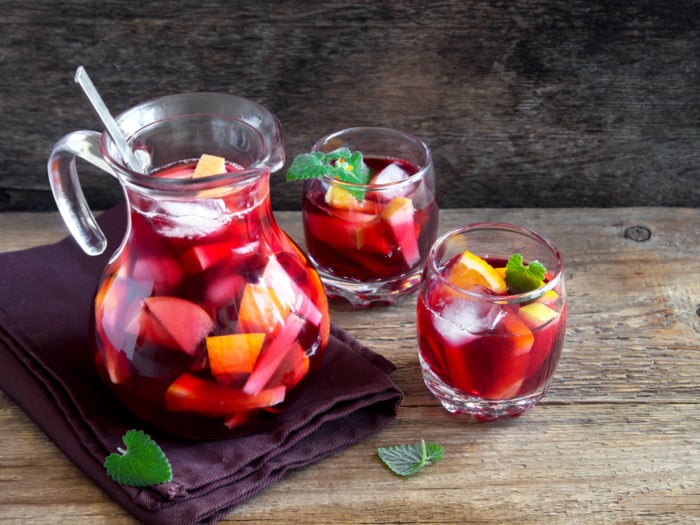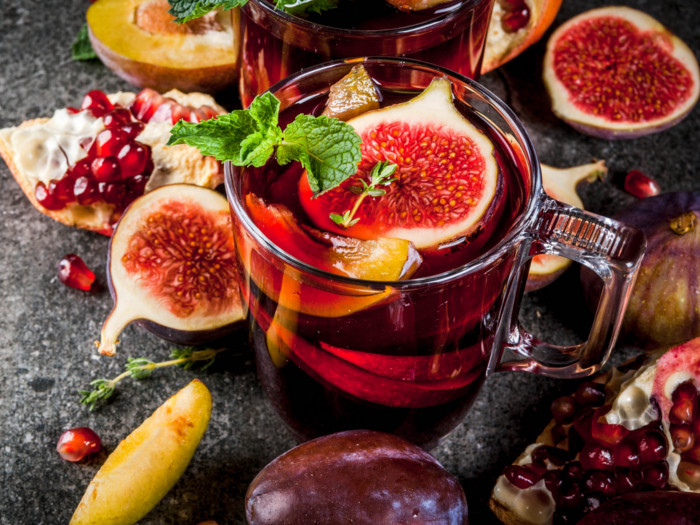Sangria is an alcoholic beverage primarily found in Portugal and Spain, but there is more to this popular drink than meets the eye.
What is Sangria?
Sangria is an alcoholic punch, primarily made from red wine with chopped fruits for flavor. The origins of this drink are Spanish and Portuguese, and this beverage is typically served over ice in the summertime. Most people consider sangria a beverage that is good for your health when consumed in moderation since it contains alcohol. Although red wine is a common base, white wine is also used in some areas. Other recipes call for mixing in orange juice or brandy for additional flavor. When it comes to taste, sangria is a sweet and fruity beverage, but its nutritional facts and calorie content will depend on what fruits are mixed in and the content of alcohol used. [1]

Typically, sangrias are made with red wine and fresh seasonal fruit. Photo Credit: Shutterstock
Sangria Nutrition Facts
Serving Size : Nutrient Value Total lipid (fat) [g] 0.04 Carbohydrate, by difference [g] 8.27 Energy 96 Alcohol, ethyl [g] 9.1 Water [g] 82.41 Sugars, total including NLEA [g] 7.16 Calcium, Ca [mg] 6 Iron, Fe [mg] 0.25 Magnesium, Mg [mg] 7 Phosphorus, P [mg] 12 Potassium, K [mg] 68 Sodium, Na [mg] 10 Zinc, Zn [mg] 0.11 Copper, Cu [mg] 0.02 Selenium, Se [µg] 0.2 Carotene, beta [µg] 1 Cryptoxanthin, beta [µg] 1 Lutein + zeaxanthin [µg] 3 Vitamin C, total ascorbic acid [mg] 0.3 Thiamin [mg] 0 Riboflavin [mg] 0.02 Niacin [mg] 0.12 Vitamin B-6 [mg] 0.03 Folate, total [µg] 1 Choline, total [mg] 3 Vitamin K (phylloquinone) [µg] 0.2 Folate, food [µg] 1 Folate, DFE [µg] 1 Fatty acids, total saturated [g] 0 16:0 [g] 0 18:0 [g] 0 18:1 [g] 0 18:2 [g] 0.01 18:3 [g] 0.01 Fatty acids, total monounsaturated [g] 0 Fatty acids, total polyunsaturated [g] 0.02 Sources include : USDA [2]
Typically, a 4-ounce serving of sangria will contain approximately 120 calories. Depending on what other liqueurs or fruits are added, in addition to sugar, the overall nutritional benefits may change. The calories can go up to 200 to 250 calories. When made with lemon-lime soda or white wine, it tends to have fewer calories.
In terms of nutrition, sangria is a source of certain antioxidants and vitamin C that are present in red wine, such as resveratrol. [3]
Potential Health Benefits
There are quite a few potential health benefits to drinking the Spanish beverage if consumed in moderation.
- Increasing antioxidant levels in the body, which prevent chronic diseases
- Lowering inflammation in the body, including that which causes arthritis, gout, and gastrointestinal problems
- Promoting cardiovascular health by lowering blood pressure
- Strengthening the immune system due to antibacterial effects [4]
- Acting as a mood enhancer
How to Make?
While this drink is widely available throughout the world at various bars and restaurants, it is also quite easy to make at home.

Sangria Recipe
Ingredients
- 1 bottle red wine
- 1/2 cup brandy
- 1/4 cup orange liqueur
- 2 apples
- 2 oranges
Instructions
- Leaving the peels on, slice up two apples and two oranges and add them to a pitcher
- Add 1/2 cup of brandy to the fruit, as well as 1/4 cup of an orange liqueur
- Add one bottle of red wine to the pitcher
- Mix the liquor, wine, and fruit. This will allow the fruits to soak up the flavors.
- Cover the container and refrigerate for four hours, or overnight. This will ensure that the fruits soak up the flavor.
- Serve chilled.

Notes
Side Effects
Considering that sangria uses red wine as a base, moderation should always be practiced when drinking this beverage. When sangria is drunk in excess, it can result in a number of side effects, including the following: [5]
- Hangover
- Dehydration
- Nausea
- Headaches
Furthermore, due to the high sugar content in certain juices, liqueurs, and fruit, some sangria recipes are not recommended for diabetics or people who are at high risk of developing this condition.

